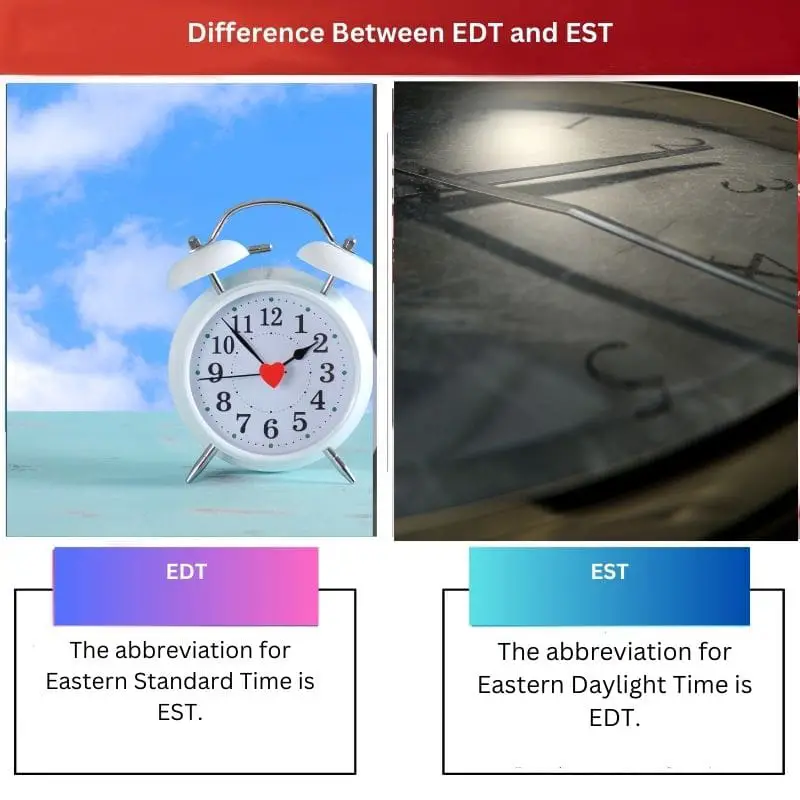Eastern Daylight Time (EDT) is used during the warmer months when Daylight Saving Time is in effect, from the second Sunday in March to the first Sunday in November. During this time, clocks are set one hour ahead of Eastern Standard Time (EST). EST, on the other hand, is observed during the cooler months when Daylight Saving Time is not in effect, from the first Sunday in November to the second Sunday in March.
Key Takeaways
- EDT is four hours behind Coordinated Universal Time (UTC-4), while EST is five hours behind Coordinated Universal Time (UTC-5).
- EDT is used during daylight saving time, while EST is used during standard time.
- EDT is used in summer, while EST is used in winter.
Difference Between EDT and EST
Eastern Daylight Time (EDT) is the time zone observed during the daylight saving time (DST) period, which starts on the second Sunday of March and ends on the first Sunday of November each year. Eastern Standard Time (EST) is the time zone observed during the standard time period.

For example: when Eastern Daylight Time is used, the international meetings are held between 10 am to 6 pm, whereas for Eastern Standard Time, the same meeting and conference are held between 9 am to 5 pm.
EST and EDT are not used in other parts of the world apart from eastern countries.
Comparison Table
| Feature | EDT (Eastern Daylight Time) | EST (Eastern Standard Time) |
|---|---|---|
| Definition | Eastern Daylight Time | Eastern Standard Time |
| Usage | Used during summer months when Daylight Saving Time (DST) is in effect. | Used during winter months when Daylight Saving Time is not in effect. |
| Time Difference | UTC-4 (Coordinated Universal Time minus 4 hours) | UTC-5 (Coordinated Universal Time minus 5 hours) |
| Relationship to EST | One hour ahead of EST | The standard time zone for the Eastern part of North America |
| Location | Primarily used in the eastern part of North America, including parts of Canada, the United States, and the Bahamas (during DST) | Primarily used in the eastern part of North America (except during DST) |
| Date Change | Starts on the second Sunday in March at 2:00 AM EST (clocks are sprung forward one hour). | Ends on the first Sunday in November at 2:00 AM EST (clocks are fallen back one hour). |
Impact on Daily Life
This table addresses the impact of EDT and EST on daily life, focusing on when daylight occurs, typical wake-up times, work hours, prime time television schedule, and school start times. Although the clock times stay the same, daylight saving time shifts daylight back into the evening.
| Parameter of Comparison | EDT (Eastern Daylight Time) | EST (Eastern Standard Time) |
|---|---|---|
| Sunlight Exposure | More evening daylight | More morning daylight |
| Typical Wake-up Time | 7:00 AM EDT | 7:00 AM EST |
| Typical Work Hours | 9:00 AM – 5:00 PM EDT | 9:00 AM – 5:00 PM EST |
| Prime Time TV | 8:00 PM – 11:00 PM EDT | 8:00 PM – 11:00 PM EST |
| School Start Time | Varies, around 8:00 AM EDT | Varies, around 8:00 AM EST |
International Correspondence
This table illustrates the relationship between EDT/EST and the time in various key international locations. It shows the time difference between Eastern Time (Daylight and Standard) and major cities worldwide. It highlights how these differences can vary depending on whether daylight saving is effective.
| Parameter of Comparison | EDT (Eastern Daylight Time) | EST (Eastern Standard Time) |
|---|---|---|
| London (BST) | 5 hours ahead | 4 hours ahead |
| Paris (CET/CEST) | 6 hours ahead/5 hours ahead | 5 hours ahead/4 hours ahead |
| Tokyo (JST) | 13 hours ahead | 14 hours ahead |
| Sydney (AEST/AEDT) | 14 hours ahead/15 hours ahead | 15 hours ahead/16 hours ahead |
| Beijing (CST) | 12 hours ahead | 13 hours ahead |
What is Eastern Daylight Time (EDT)?
Eastern Daylight Time (EDT) is a time zone observed in regions of North America during the warmer months of the year. It is part of the Eastern Time Zone (ET), which covers a significant portion of the eastern United States and Canada. EDT is used when Daylight Saving Time (DST) is in effect, and it is characterized by setting the clock one hour ahead of Eastern Standard Time (EST).
Daylight Saving Time
Daylight Saving Time is a practice where clocks are adjusted forward by one hour during the warmer months to maximize daylight hours in the evening. This adjustment occurs on the second Sunday in March when clocks “spring forward” one hour, marking the beginning of EDT. Daylight Saving Time ends on the first Sunday in November, when clocks are set back one hour to Eastern Standard Time (EST), concluding the period of EDT observation.
Geographic Scope
EDT is observed in regions within the Eastern Time Zone, encompassing states such as New York, Florida, and parts of Canada including Ontario and Quebec. It is used to synchronize timekeeping across these areas during Daylight Saving Time, ensuring consistency in scheduling, communication, and various aspects of daily life.
Effects and Applications
The transition from EST to EDT and vice versa affects numerous aspects of society, including transportation schedules, business operations, and individual routines.

What is Eastern Standard Time (EST)?
Eastern Standard Time (EST) is a time zone observed in regions of North America during the cooler months of the year. It is part of the Eastern Time Zone (ET), which covers a significant portion of the eastern United States and Canada. EST is used when Daylight Saving Time (DST) is not in effect, and it represents the standard time for this geographic region.
Daylight Saving Time
Daylight Saving Time is a practice where clocks are adjusted forward by one hour during the warmer months to maximize daylight hours in the evening. When Daylight Saving Time ends on the first Sunday in November, clocks are set back one hour to revert to Eastern Standard Time (EST), marking the transition from EDT to EST. During this period, the clock returns to its standard time, and there is no adjustment for daylight hours.
Geographic Scope
EST is observed in regions within the Eastern Time Zone, encompassing states such as New York, Florida, and parts of Canada including Ontario and Quebec. It serves as the standard timekeeping reference during the fall and winter months when Daylight Saving Time is not in effect. This standardization ensures consistency in scheduling, communication, and various aspects of daily life across the affected areas.
Effects and Applications
The transition from EDT to EST and vice versa influences various facets of society, including transportation schedules, business operations, and individual routines. During EST, daylight hours are shorter, leading to adjustments in activities and schedules to accommodate the reduced daylight.

Main Differences Between Eastern Daylight Time (EDT) and Eastern Standard Time (EST)
- Time Adjustment:
- EDT (Eastern Daylight Time) is observed during Daylight Saving Time, with clocks set one hour ahead of standard time.
- EST (Eastern Standard Time) is used when Daylight Saving Time is not in effect, maintaining the standard time for the Eastern Time Zone.
- Seasonal Application:
- EDT is used during the warmer months, from the second Sunday in March to the first Sunday in November.
- EST is observed during the cooler months, from the first Sunday in November to the second Sunday in March.
- Daylight Hours:
- EDT provides longer daylight hours in the evening due to the one-hour time adjustment.
- EST represents the standard time with no adjustments for daylight, resulting in shorter daylight hours during fall and winter.
- Geographical Implications:
- Regions within the Eastern Time Zone switch between EDT and EST based on the time of year, affecting scheduling, communication, and various aspects of daily life.
- The transition between EDT and EST impacts transportation schedules, business operations, and individual routines.
EDT vs EST
Eastern Daylight Time (EDT) and Eastern Standard Time (EST) are two time zones used in North America, primarily in the eastern part of the continent. Understanding the difference between these time zones and when to use each is essential for accurate scheduling and communication.
EDT stands for Eastern Daylight Time. This time zone is observed when daylight saving time is in effect, between spring and fall. EDT is four hours behind Coordinated Universal Time (UTC-4). During this period, clocks in the eastern region are moved an hour forward to better use daylight.
In contrast, EST stands for Eastern Standard Time. This time zone is observed during the fall and winter when daylight hours are shorter, from November to March. EST is five hours behind Coordinated Universal Time (UTC-5).
Switching between these time zones occurs twice a year. When transitioning from EST to EDT, you must set your clocks forward by one hour, effectively “losing” an hour of sleep. Conversely, when transitioning from EDT back to EST, you’ll need to set clocks back an hour, “gaining” an extra hour of sleep.
To avoid confusion, it is recommended to use the term Eastern Time (ET) when referring to time in the Eastern region in general. This term is used without considering daylight saving and standard time differences.
Knowing the distinctions between EDT and EST can help you plan more effectively and ensure clear communication. Always double-check the time zone when scheduling meetings or events with colleagues or friends in different regions, as this can prevent misunderstandings and missed appointments.
Implications of the Differences
Understanding the difference between Eastern Daylight Time (EDT) and Eastern Standard Time (EST) is crucial as you navigate the world of timekeeping. Both time zones are used primarily in the eastern portion of North America, but serve different purposes in our daily lives.
You’ll be operating on Eastern Standard Time (EST) during the fall and winter months. This is when daylight hours are shorter, and the time reads as Coordinated Universal Time (UTC-5). Knowing this can help you plan events and appointments considering time zone differences, especially when communicating with people from other parts of the world.
When the warmer months roll in, you should switch to Eastern Daylight Time (EDT), which is an hour ahead of EST. This is designed to provide more daylight during evening hours and effectively utilise sunlight. As a result, your daily activities and work hours may see some changes. It is essential for you to adjust your clocks and devices accordingly, as it impacts your daily life and various industries.
Furthermore, accurately using EDT and EST can prevent misunderstandings when scheduling international events or conference calls. This clarity ensures proper coordination among global participants. Keep in mind that countries outside North America might observe similar daylight-saving time shifts, so staying informed about the appropriate time zones used during different seasons will maintain smooth communication.
Understanding the distinctions between EDT and EST will enhance your ability to manage time-sensitive scenarios and maintain successful communication with people across diverse regions. Stay informed and adapt to these changes to maximise the seasonal daylight benefits.
Workplace Impact
In today’s interconnected world, professionals need to understand the difference between Eastern Standard Time (EST) and Eastern Daylight Time (EDT). Miscommunication about time zones can lead to missed meetings, deadline confusion, and reduced productivity. This section will discuss the impact of EDT and EST on the workplace and ways to mitigate any potential challenges.
Firstly, it’s important to know the distinction between EDT and EST. EST stands for Eastern Standard Time, which is observed during the non-daylight saving time months. On the other hand, EDT (Eastern Daylight Time) is observed during daylight saving time. This means that the time zone switches from EST to EDT when the clocks are moved forward one hour in the spring.
For organizations with teams across different time zones, understanding the distinction between EST and EDT is crucial for effective communication and collaboration. Knowing the correct time zone can prevent confusion and misunderstandings when scheduling meetings or setting deadlines. Moreover, getting acquainted with the daylight saving time schedule helps you stay on top of the changes in time zones.
To manage the impact of EDT and EST differences on your workplace, consider adopting some of the following strategies:
- Calendar tools: Modern calendar tools have built-in features to display and convert between different time zones, ensuring successful cross-time-zone scheduling.
- Clear communication: When discussing time-related matters, include the appropriate time zone (EST or EDT), reducing the risk of misunderstandings.
- Time zone awareness: Educate yourself and your team members on the differences between EST and EDT and the daylight saving time schedule to improve overall time zone literacy.
In conclusion, understanding the nuances of EST and EDT and their impact on the workplace is crucial to professional life. By implementing the abovementioned strategies, you can maintain effective communication and collaboration, minimizing potential disruptions and improving overall productivity.
Worldwide Relevance
In today’s interconnected world, understanding the differences between Eastern Standard Time (EST) and Eastern Daylight Time (EDT) is essential for coordinating travel, communication, and business across international borders. The Eastern Time Zone (ET) is relevant to numerous countries and regions, including the eastern part of the United States, eastern Canada, and parts of Mexico, such as Quintana Roo.
When discussing EST, it is important to remember that it is in effect during the autumn and winter seasons, and places observing this time zone are five hours behind Coordinated Universal Time (UTC-5). For example, if it is 12:00 PM (noon) in UTC, it will be 7:00 AM EST.
On the other hand, EDT is observed during the spring and summer seasons, when daylight saving time is in effect. During this time, clocks are adjusted one hour ahead, making EDT four hours behind Coordinated Universal Time (UTC-4). So, when it is 12:00 PM (noon) in UTC, it will be 8:00 AM in EDT.
As you plan international meetings or events, remember the difference between EDT and EST to ensure accurate scheduling. Many digital tools, like online time converters, can help you quickly and easily convert specific times between EDT, EST, and other zones.
Additionally, staying informed about the local time in the Eastern Time Zone is crucial for those conducting business, touring, or living in this region. Understanding the distinction between EST and EDT will allow you to smoothly navigate time-related concerns during your travels, communication, and professional activities.
Technological Considerations
When dealing with EDT and EST, it is crucial to consider the technological aspects that can impact your daily activities and communication. As you work with colleagues or clients in different time zones, understanding the difference between EDT and EST is essential to ensure smooth collaboration across borders.
One significant technological consideration is the synchronization of time across devices. To avoid scheduling conflicts or miscommunication, your computers, smartphones, and other digital devices must be configured to update between EDT and EST automatically. To achieve accurate synchronization, use tools and software designed for this purpose. This can include built-in operating system features or third-party applications.
Another important consideration is the application of time zone conversions when scheduling meetings or events. Use digital calendars or scheduling tools that automatically convert time zones to prevent confusion. Many popular calendar applications, such as Google Calendar and Microsoft Outlook, offer this feature and can help you better manage your time within the Eastern Time Zone.
Here are some key guidelines when working with EDT and EST:
- Awareness: Always be aware of the current time in both EDT and EST when communicating with others in the Eastern Time Zone. Keep track of daylight saving time changes to ensure accurate understanding of the local time.
- Clear communication: Clearly indicate the time zone when scheduling events, meetings, or setting deadlines. This will minimize confusion and allow everyone involved to be on the same page.
- Timely software updates: Keep your devices and software updated to ensure they accurately handle time zone changes.
By following these technological considerations and leveraging the appropriate tools, you can effectively manage and coordinate with people across the Eastern Time Zone, ensuring seamless collaboration and communication.
The Role of Daylight Savings
Daylight Saving Time (DST) plays a significant role in the difference between Eastern Daylight Time (EDT) and Eastern Standard Time (EST). As a resident of the Eastern Time Zone in North America, you need to understand how these time zones work and the impact of DST on your daily life.
During the warmer months, from the second Sunday of March to the first Sunday of November, the local time in regions observing DST is adjusted forward by one hour. This is when the Eastern Time Zone transitions from EST to EDT. The primary purpose of DST is to make better use of daylight and conserve energy. When DST is in effect, you’ll notice that the evenings have more daylight, allowing for increased productivity and leisure activities.
It’s important to remember the time change when planning your activities, especially if you’re communicating with people from areas that do not observe DST. For example, some places that use EST year-round include Nunavut’s Southampton Island (Coral Harbour), Quintana Roo in Mexico, the Cayman Islands, Jamaica, and Panama. So, when you’re coordinating with others from different time zones, consider the hour difference caused by DST.
As a resident of the Eastern Time Zone, you should know that “Eastern Time” is used without specifying whether it’s about EDT or EST. Since Eastern Time switches between these two time zones during the year, paying attention to the dates when daylight saving begins and ends is crucial to stay on top of the correct time.
In summary, by understanding the role of daylight saving in differentiating EDT vs EST, you can better manage your time, coordinate with others, and make the most of the daylight hours during the warmer months.
Effects on Global Business
Understanding the difference between EDT and EST is vital for successful global business operations in today’s interconnected world. When scheduling meetings, coordinating project timelines, or communicating across time zones, it’s essential to be aware of these time differences. This will help you avoid confusion or misunderstandings, ensuring smooth and efficient collaboration with international colleagues and clients.
To begin with, you should be aware that EST (Eastern Standard Time) is 5 hours behind Coordinated Universal Time (UTC-5). This is the standard time zone observed during the non-daylight saving period in the Eastern Time Zone. On the other hand, EDT (Eastern Daylight Time) is the time zone observed during daylight saving time in the same area and is 4 hours behind UTC (UTC-4).
One of the challenges of global business is managing time-sensitive tasks and communications. Knowing when to use EST and EDT can help ensure your deadlines are met and time-sensitive tasks are completed on schedule. For instance, imagine coordinating a conference call between your team and a client based in London. If the call is set to take place during daylight saving time, you should use EDT when scheduling the meeting. Conversely, you should use EST if the call is scheduled during the non-daylight saving period.
Another aspect to consider is using ET as a catch-all term for either EST or EDT when you’re unsure which to use. This can help alleviate confusion by providing a general reference to Eastern Time without specifying whether it’s daylight saving time or standard time.


The in-depth comparison between EDT and EST, along with the impact on daily life and international correspondence, offers a comprehensive understanding of the topic.
This article clears up any confusion about the differences between EDT and EST in different months, geographic coverage, and transition timings.
The information about the transition timing and notable regions under EDT/EST is very helpful and adds context to the broader explanations in the article.
While the article provides comprehensive details about EDT and EST, it doesn’t highlight the potential drawbacks or criticisms of daylight saving time, which could offer a more balanced view.
I see your point, but the focus of the article seems to be on factual information rather than subjective opinions.
The inclusion of international correspondence tables enhances the practicality of the information provided in the article.
I agree, the international time differences are well-presented and serve as a useful guide for global interactions.
It’s interesting to see how the time difference between EDT and EST affects daily activities and international correspondence. The tables are very useful for quick reference.
Absolutely, the impact on daylight, work hours, and global time differences is well-explained in the post.
It’s intriguing to see the impact of artificial lighting and energy conservation as a result of the time change. The post explains this concept effectively.
Indeed, the environmental considerations associated with EDT and EST are thought-provoking.
The practical examples illustrate the significance of daylight saving time from an environmental perspective.
The article explains the geographical coverage and transition to EDT/EST with important details. It’s a well-researched piece with valuable insights.
The impact on daily life and international correspondence based on EDT/EST is well outlined, making it easier to comprehend.
I appreciate the depth of information about the transition and notable cities in the region.
This article provides an in-depth analysis of the differences between EDT and EST in a clear and concise manner. The information can be very useful for international businesses or travelers.
I agree, the content is very informative and provides practical examples for a better understanding.
While the post offers valuable details on the transition and notable cities, it overlooks the historical context of daylight saving time and its implications.
The focus on the technical aspects of EDT and EST is necessary for clarity, though a brief historical context could be a valuable addition.
I understand your point, but the article seems more focused on the technical aspects rather than historical relevance and implications.